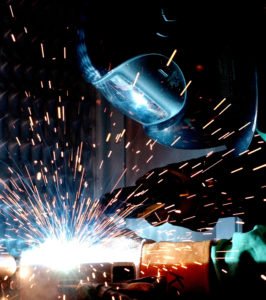A Freedom of Information request to Welsh Fire & Rescue Service, submitted by health and safety training provide CE Safety has uncovered that there were 17 fires caused by hot works in the Welsh construction sector last year.
 Hot works, as defined by the British Standards Institution (BSI) in BS 9999, is: ‘Any procedure that might involve or have the potential to generate sufficient heat, sparks or flame to cause a fire.’ Essentially, any task that requires using open flames or applying heat or friction which may generate sparks or heat.
Hot works, as defined by the British Standards Institution (BSI) in BS 9999, is: ‘Any procedure that might involve or have the potential to generate sufficient heat, sparks or flame to cause a fire.’ Essentially, any task that requires using open flames or applying heat or friction which may generate sparks or heat.
Examples of hot works include welding, flame-cutting, soldering, brazing, grinding and the use of other equipment incorporating a flame.
Hot works pose a particular threat within the construction sector as the cause of multiple fires in buildings. The most common examples of hot works and those that can pose significant risks without proper safety precautions are, for example:
- Brazing and soldering;
- Gas/electric welding cutting apparatus;
- Grinding wheels and cutting discs;
- Thawing pipes;
- Open flames, blow lamps and blow torches;
- Bitumen and tar boilers;
- Hot air blowers and lead heaters.
According to figures from Fire and Rescue Service in South Wales, there were three fires in buildings under construction caused by hot work. Two incidents were caused by soldering and one by welding.
The North Wales Fire & Rescue Service confirmed one incident in a building under construction, which was caused by welding/cutting equipment.
The Mid and West Wales Fire & Rescue Service recorded 13 incidents related to ‘welding equipment’ within various property types.
The causes were also divided into:
- Careless handling – due to careless disposal;
- Combustible articles too close to a heat source (or fire);
- Natural occurrence;
- Negligent use of equipment or appliance (heat source).
Fire hazards posed by hot works
Flying sparks are the principal risk posed by hot works and they can easily get trapped in cracks, pipes, gaps, holes and other small openings, where they could potentially smolder and cause a fire to break out.
The debris and residue which hot work creates, such as flammable swarf, molten metals, slag, cinder, and filings, are often combustible.
Hot works can cause pipes to substantially heat up and easily transfer, through the process of conduction, to another flammable surface and cause a fire.
Failure to remove flammable materials or substances from a surface before commencing work means that they could easily become hot and cause a fire.
In certain environments, there may be potentially explosive vapours or gases in the air which are highly combustible and could ignite if exposed to hot works. In a similar vein, hot works could generate fumes which, in turn, create an explosive atmosphere.
Due to the high-risk nature of hot works, the BS 9999 and the HSE outlines various safety procedures which organisations must adhere to. Their aim is to protect workers from dangerous aspects of hot work and to prevent fires from breaking out.
Fire Safety in 2023 eBook
SHP's sister site, IFSEC Insider has released its annual Fire Safety Report for 2023, keeping you up to date with the biggest news and prosecution stories from around the industry.
Chapters include important updates such as the Fire Safety (England) Regulations 2022 and an overview of the new British Standard for the digital management of fire safety information.
Plus, explore the growing risks of lithium-ion battery fires and hear from experts in disability evacuation and social housing.

 Hot works, as defined by the British Standards Institution (BSI) in BS 9999, is: ‘Any procedure that might involve or have the potential to generate sufficient heat, sparks or flame to cause a fire.’ Essentially, any task that requires using open flames or applying heat or friction which may generate sparks or heat.
Hot works, as defined by the British Standards Institution (BSI) in BS 9999, is: ‘Any procedure that might involve or have the potential to generate sufficient heat, sparks or flame to cause a fire.’ Essentially, any task that requires using open flames or applying heat or friction which may generate sparks or heat.